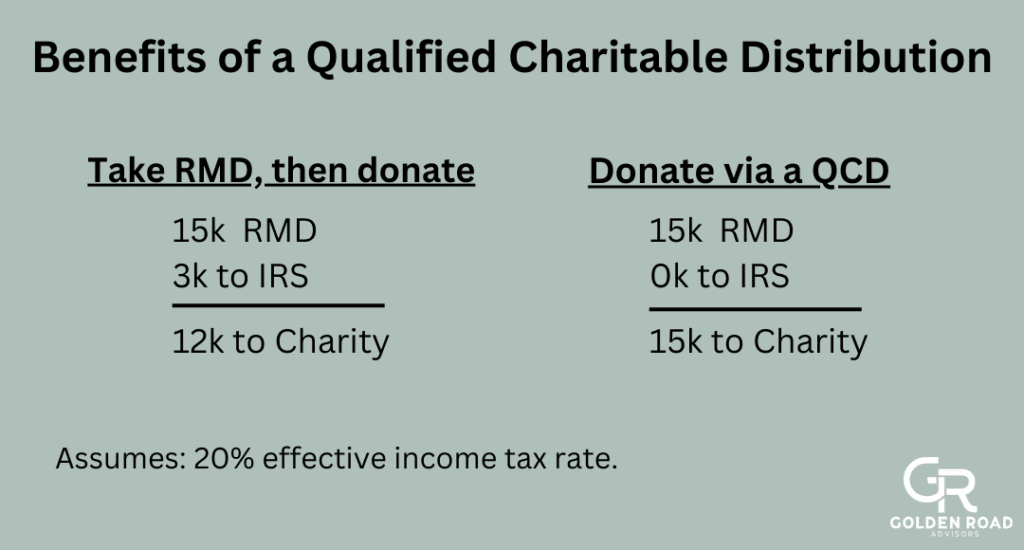
Donating to charity is a habit I admire, regardless of your tax situation. But if you are charitably minded, seeking charitable giving strategies that provide an emotional and financial benefit is wise. Even though the Tax Cuts and Jobs Act of 2018 resulted in a high standard deduction and made itemizing less fruitful, evaluating your income and tax situation can still reveal opportunities for lowering your tax bill.
I will lay out some options below, but first, let’s look at a legal vehicle that makes implementing such strategies easier.
Vehicles That Support Charitable Giving Tax Strategies
Donors have been making charitable gifts through private foundations and trust structures for years, and there is a potential solution for every situation.
For instance, charitable lead trusts allow you to put money aside to distribute to charity during your lifetime, and whatever remains goes to your beneficiaries. Charitable remainder trusts reverse that situation. Donor-advised funds (DAFs) allow tax-advantaged, lump-sum donations but spread out charity grants over time.
Due to their extreme simplicity, DAFs are one of the most popular charitable planning tools.
What Are Donor-Advised Funds and How Do They Work?
Donor-advised funds are charitable pools of money administered by financial institutions. They operate similarly to private foundations but with a much lower minimum asset size and far less administrative work, making them accessible to more people.
The mechanics are simple. You establish a fund under your name (for example, the Smith Family Foundation, etc.), make a donation, and claim the tax deduction that same year. Then, the fund administrator invests the funds (so they can grow) and makes charitable grants to organizations you choose on your preferred timeline.
The ease of this vehicle makes it a no-brainer for most charitably inclined families, but here are a couple of other reasons why we recommend it.
- All charitable foundations and trusts must distribute 5% to charity every year. If you set up a private vehicle, you are responsible for ensuring that happens. Since donor-advised funds pool money from multiple donors and are managed by a financial institution, you don’t have to worry about that.
- Donor-advised funds are inexpensive to establish and maintain (set-up is usually free, and ongoing fees are typically about 1% annually). On the other hand, setting up a private structure requires the assistance of a lawyer and tax advisor.
These factors make donor-advised funds the clear choice for most people, with only the wealthiest of families qualifying for private foundation establishment. The only caveat is that donor-advised funds only take cash or securities, and all donations must go to qualified non-profits.
Here are some examples of how this vehicle could be beneficial.
Example Uses for a Donor-Advised Fund

Imagine you had a great year at work and received a huge bonus. You’d like to reduce taxable income by donating to charity. The problem is you don’t want to do it all at once. If you make a large gift, there will be notoriety and expectations of future gifts.
That is precisely the type of situation that calls for a donor-advised fund. You put cash (or appreciated stock held long-term) into the fund today, take any tax savings immediately, and advise the fund to make grants to your chosen charities on your preferred timeline.
But that’s just one possible scenario. For example, imagine you are 70, just sold a business, and typically give 10k to charity annually. You could put $250,000 of your proceeds into a fund today, take the income tax deduction in the current tax year1, and continue that same rate of giving until you are 95 without budgeting another dime. Since the money is invested, your gifts will likely grow at or above inflation rates.
I could go on, but you get the idea. Donor-advised funds allow you to take advantage of any tax benefits today while donating to charity over time.

6 Charitable Giving Strategies
Below are six tax strategies for charitable giving, but I want to give you some context before we dig in.
- Items 1 through 4 are perfect for pairing with a donor-advised fund. Use these techniques to contribute money or securities whenever it makes sense, then use the fund to smooth out the amount of your donations over time.
- We love strategy five, but these transactions must occur directly with your charity of choice. I.e., you cannot use a donor-advised fund for qualified charitable distributions (QCDs).
- The sixth strategy is a long-term play that applies to anyone who wishes to leave a portion of their estate to a charitable organization when they pass.
Finally, please know that while these strategies will help you improve the world while getting a tax break, they assume you have excess cash or property. We can never know if such an excess exists without taking the time to develop a plan first
Table of Contents
- Bunching Charitable Donations
- Time Gifting to Reduce Your Taxable Income During Big Years
- Time Giving to Mitigate Capital Gains
- Donate Appreciated Securities or Property Directly to Charity
- Make Qualified Charitable Distributions from an IRA
- Name a Charity as a Beneficiary on Tax-Deferred Accounts
1. Bunching Charitable Donations
Itemized deductions are only possible if you surpass the standard deduction, which is currently relatively high. However, if you routinely give to charity, bunching 2 or 3 years of donations together could make that happen. Let me show you how it works.
Imagine you are a married couple that files jointly. You typically give $15,000 to charity each year and could claim another $10,000 in deductions. You will never pass the $27,700 standard deduction.
However, you could take a charitable deduction if you bundle two years of donations together – giving $30,000 to charity this year (and skipping the next). Then, you could repeat that process as often as you like.

If giving $30,000 away this year isn’t feasible, consider skipping your year-end donation and doing it in January instead. Then, donate next December as usual and continue that process going forward to arrive at a bundling strategy like this.

2. Time Gifting to Reduce Your Taxable Income During Big Years
If your income fluctuates yearly, consider letting the amount of your charitable donations fluctuate, too, especially if doing so will keep you from straying into the next income tax bracket. That will allow you to reduce your taxable income when it counts.
What types of events might trigger this strategy? Below are a few examples, but I’m sure you could come up with more of your own.
- A large vest of Restricted Stock Units (RSUs) or stock option exercise.
- A huge bonus.
- Sale of a significantly appreciated asset (like a business or real estate).
- An exceptionally lucrative but temporary contracting gig.
- A Roth IRA conversion.
- A taxable inheritance or significant cash gift.
3. Time Giving to Mitigate Capital Gains
Sometimes, you have no choice but to harvest capital gains. Take advantage of these moments to kick up your charitable gifting for the year. This strategy works similarly to #2 above and includes some of the same triggers, but in this case, I’m thinking specifically of events like the following.
- The sale of a business.
- A merger or acquisition that results in the sale of restricted stock.
- The liquidation of property.
4. Donate Appreciated Securities or Property Directly To Charity or a DAF
If you have been holding onto appreciated stock or property you don’t need for at least a year and want to donate to charity, consider gifting that asset directly to the organization of your choice (or your donor-advised fund). That will allow you to claim a tax deduction for the gift AND avoid any capital gains tax you would have paid if you sold it outright.
If you must choose, I recommend doing this instead of donating cash because the benefit is outstanding. You get to deduct the entire market price from your income (subject to annual limits1) and get the emotional win of giving something to charity. And the charity receives the total value of that asset.

5. Make Qualified Charitable Distributions (QCDs) from an IRA
If you are subject to Required Minimum Distributions (RMDs) and plan to take the standard deduction, there is another opportunity along these lines.
Distributions from taxable retirement accounts typically count as ordinary income, resulting in a tax liability and potentially affecting your Medicare insurance premiums. But if you don’t need that money, you can donate it directly to charity and eliminate this concern.
The charity gets the total amount, and you get to avoid paying taxes on that money, but you don’t have to itemize to get the benefit. You can still claim the standard deduction at tax time. So, once again, it’s a potential win-win!

6. Name a Charity as a Beneficiary on Tax-Deferred Accounts (Long-Term)
The abovementioned strategies are all meant to reduce your tax burden in the short term. But it is worth thinking ahead if you also want to leave money to charities at the end of your life.
In 2022, congress passed the Secure Act 2.0 to help people save more money for retirement. But one of the downsides of that bill is that it also eliminated something called the “stretch provision.” When beneficiaries inherit a traditional IRA (or other tax-deferred account), they must now liquidate it within ten years (instead of over their lifetime). That could result in a lot of taxes for your beneficiaries!
For this reason, many people are adjusting their estate plans to ensure that they leave money to their families, not Uncle Sam. If you have plenty of non-taxable assets to give to your family and want some money to go to charity, consider naming charities as the beneficiaries of your IRAs or annuities. The charities are tax-exempt and will get a more significant benefit.
Charitable gifts through beneficiary designations also reduce the size of your estate for estate tax calculations.
Charitable Gifting Strategies: The Bottom Line
If you are charitably minded, there are still plenty of ways to receive tax benefits, even when the standard deduction is relatively high. But you must get creative. So, review these opportunities in light of your situation, or reach out, and we can discuss it.

Footnotes:
1The IRS limits deductible charitable cash contributions to 60% of your adjusted gross income. The limit for deductible non-cash assets is 30% of your adjusted gross income. But you can carry over any excess to future tax years.
Author
-

Kevin Caldwell is a principal at Golden Road Advisors and a CERTIFIED FINANCIAL PLANNER™ (CFP®️) practitioner with over 15 years of experience in the financial services industry. In addition to providing advice and guidance to clients, he regularly contributes to publications such as Kiplinger, Yahoo! Finance, Dalbar, and MarketWatch.
View all posts



